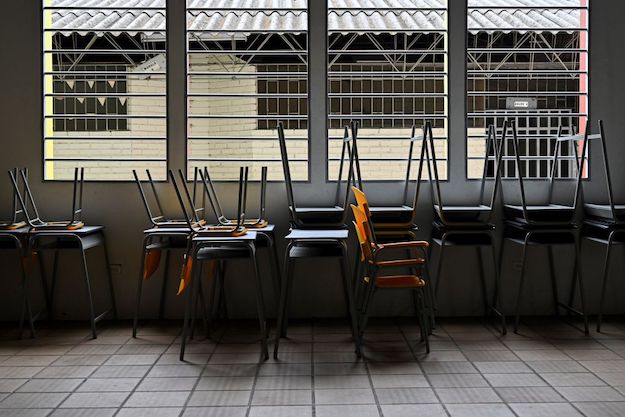This article is adapted from AQ’s special report on transnational organized crime.
TUMACO, Colombia— Lidia Cruz, a community leader in southern Colombia, spends her days trying to prevent children and young adults from being forced to join drug trafficking groups. When all else fails, she covertly helps evacuate potential recruits to safer areas of the country.
One of the most recent evacuees: her own son.
He had been attending a technical college in the Pacific coast city of Tumaco. But classes were cancelled in March as the COVID-19 pandemic erupted, so he and other students began spending their newfound free time playing soccer. That caught the attention of Los Contadores, a gang whose members began hanging around the soccer field, bragging about their exploits and flashing weapons.
“My son was telling me, ‘Mom! These men are showing us their guns and their money!’” Cruz recalled. “I had to get him out of there.”
Cruz sent her son to live with his grandfather near Bogotá, the Colombian capital. But his sudden departure angered Los Contadores, who then began harassing Cruz, a prominent activist, and warning that she had better watch her back.
Cruz, who insisted I not use her real name, told me that Los Contadores and half a dozen other armed groups are fighting for control over the cocaine business in and around Tumaco and are constantly on the lookout for fresh foot soldiers. When youths resist, Cruz told me, the gangs will sometimes take them away at gunpoint.
“They will come up to a mother and say, ‘Give me your son or I will kill you,’” Cruz said.
As 2020 drew to a close, more than 97% of students across Latin America remained physically out of school because of COVID, according to a study by UNICEF. This has been a disaster for the region’s education systems — and a potential bonanza for criminal organizations, who suddenly have an even bigger pool of idle young people to recruit from.
It’s unclear whether gangs have had much success growing their ranks elsewhere in the region. But in Colombia, government officials and civil society organizations have documented a sharp increase in forced recruitment since the pandemic began. The Bogotá-based Coalition Against the Involvement of Children and Young People in Colombia’s Armed Conflict, or COALICO, reported that at least 190 minors were recruited during the first six months of 2020 — five times the number it tracked a year earlier. This likely represented only a small percentage of the actual cases, given the fear many families have of reporting such episodes.
“There has been a big jump in recruitment,” said Julia Castellanos, a researcher for COALICO.
It’s an alarming state of affairs for a country that has seen drug-fueled violence diminish sharply over the past 15 years, and where the government signed a historic 2016 peace treaty. Now, in Colombia and elsewhere, there are fears that the desperation engendered by the pandemic could draw a new generation into a life of crime.
Colombia imposed one of Latin America’s longest lockdowns, which lasted until September, and officials expected the economy to contract about 7% in 2020. Officially, unemployment has jumped from 9.8% to 14.7%, but that doesn’t take into account the millions of informal jobs that have disappeared.
“The dynamic has changed during the pandemic,” said a Tumaco-based lawyer who has regular contact with the region’s criminal groups, and requested anonymity. “For many families, the money that these groups offer is their best option and their only option.”
The gunmen start wooing potential recruits by handing out cash, clothes and cell phones, the lawyer said. They romance young women and sometimes get them pregnant so they feel obligated to join. They will even provide groceries and prescription drugs to win over the families of the youths they covet. The youngest recruits start out as part-time lookouts. Full-timers receive weapons, monthly stipends of $300 to $600, plus a motorcycle.
A Drug Economy
In places like Tumaco, such offers can be hard to resist.
The densely packed city is built on three islands just off the Pacific Coast, near Colombia’s border with Ecuador. The region is populated by Afro-Colombians, the descendants of enslaved people who were first brought here in the 1500s to mine gold and cut timber. These days legal job opportunities are limited, and drug smuggling drives much of the economy.
“When 20 get locked up, they recruit 30.”
– Lidia Cruz, community leader
Coca bushes, whose leaves provide the raw material for cocaine, dot the countryside. Mangrove swamps and estuaries provide clandestine launching sites for drug-filled boats and homemade submarines heading to drop-off points in the waters off Central America and Mexico. When Colombian security forces arrest or kill members of trafficking groups, Cruz said, they can easily be replaced.
“When 20 get locked up,” she said, “they recruit 30.”
Sometimes the only way for families to protect their sons and daughters is by evacuating them to other parts of the country. That’s when Cruz steps in.
In April, for example, three families abandoned their homes along the Mira River near the Ecuadorian border to prevent their kids, including a 10-year-old boy, from being recruited. On boats and by foot, they made their way to Cruz’s cramped house near Tumaco. There, they hid as Cruz spent three months badgering local officials until they could arrange transportation for the families to leave the region.
When criminal groups are recruiting, Cruz said, “The biggest problem you can have is telling them, ‘no.’”
Such stories rekindle memories of an agonizing era most Colombians hoped was over. I first reported on forced recruitment during the height of the country’s guerrilla war in the early 2000s. While visiting rebel camps I saw camouflage-clad kids cleaning automatic rifles, a task they were good at because their hands are so small. On the outskirts of Bogotá, I toured a shelter housing former child warriors whose memories were jogged during the evening snack of popcorn.
“When they hear the corn popping, they say, ‘That’s what it sounds like in combat,’” Marcela Bernali, a child psychologist, told me at the time.
The Revolutionary Armed Forces of Colombia, or FARC, used profits from cocaine smuggling to become the country’s largest rebel army, with some 17,000 fighters. Many were forcibly recruited and by some estimates about one-third were minors. Under the 2016 peace accord, the FARC officially laid down its weapons and became a legal, left-wing political party. Yet even so, Colombia’s peace has been partial — with forced recruitment a recurring nightmare.
At the heart of the problem, said Jeremy McDermott, co-director of the research group InSight Crime, is the failure of Colombia’s police and army to provide security in regions abandoned by the FARC.
Several armed groups have stepped into the vacuum, like Los Contadores, that are led by so-called dissident FARC members who have rejected the peace process, rearmed, and now focus almost exclusively on smuggling drugs. Another key player is the National Liberation Army, or ELN, a 55-year-old guerrilla army long overshadowed by the FARC that is now expanding.
All of these groups battle for control over territory and trafficking routes and compete for young recruits.
“It’s very sad but kids make good soldiers,” said Juan Sebastián Campo of the Bogotá group Benposta, which operates programs for at-risk youths in conflict zones.
“A 15-year-old boy or girl can march up and down the mountains faster than a fat old commander. We have dealt with 17-year-olds who were excellent snipers.”
Refugees on the Line
The pool of potential recruits has also expanded thanks to the estimated 2 million Venezuelans who have fled to Colombia, escaping joblessness, food shortages and authoritarian rule back home. In Colombia’s Catatumbo region along the Venezuelan border more than half of all recent recruits have been Venezuelans, said Carmen García, president of the human rights group Mothers of Catatumbo.
During security operations over the past three years, Colombian police and soldiers rescued 1,509 minors from criminal groups, according to Nancy Patricia Gutiérrez, the top human rights advisor to Colombian President Iván Duque. These figures are similar to those registered in the mid-2000s when the war was far more intense, said Paola González, a researcher for the Bogotá-based Ideas for Peace Foundation.
“All the data show that the numbers are going up,” she told AQ.
In one case on a Monday morning shortly after the pandemic began, a teenage boy was hanging out in a pool hall in the northern Colombian state of Arauca. Suddenly, members of the ELN guerrilla group burst in looking for fresh recruits. The boy resisted so the rebels put a gun to his head.
“They said, ‘Why don’t you just save us the bullet?’” said Claudia Arango, the head of the parent-teacher association at the public school where the boy had been studying.
Then, she said, the rebels tied up the teenager and marched him into the jungle.
Arango, which is a pseudonym, insisted that the adolescent would have evaded the rebel recruiters had he been in class as usual. She described schools as sanctuaries that allow students to eat a decent meal, get away from abusive parents, discuss personal problems with teachers, get involved in music or sports, and find direction for their lives.
“When kids are in school, their minds are occupied,” Arango said. “But when they’re not in class they have more time to hang out with folks who are not good for them. These people arrive at their homes and tell them that studying is a waste of time. They start to brainwash them.”
Many expect these circumstances to outlast the pandemic itself. A recent study by academics including Nora Lustig of Tulane University estimated that the percentage of Latin American students who complete high school may fall from 61% to 46% because of the pandemic. The high school completion rate could decrease by as much as 20 percentage points among students whose parents have lower education levels, the study found.
In Colombia, although millions of students in urban areas have switched to online learning, small towns and villages often lack decent Internet service and are sometimes off the grid altogether.
That’s the case in and around Arauquita, a town located just across the Arauca River from Venezuela. There, virtual learning has been impossible because most kids lack computers, telephones and access to the Internet, said Joel Llanes, the local human rights official.
Instead, school consists of teachers handing out worksheets to their pupils and collecting them every few months. But Llanes says many students have lost interest and that 10% have quit since the pandemic began.
“We assume that some of these students dropped out and were recruited,” Llanes said.
The most dramatic testimony I heard about the vital role of schools in protecting children came from a 17-year-old girl who grew up in a village a few hours south of Arauquita. We spoke via Zoom, and she asked me to identify her only as Erica.
“I always felt safe at school because the professors would take care of me,” Erica said. “But I felt scared going home.”
ELN rebels roamed her neighborhood and occasionally stopped to chat with her mother. One day she arrived home to find an ELN gunman on a motorcycle waiting for her. She protested but her mother, for reasons still unknown to Erica, told her she had to go with him.
In the jungle, the guerrillas taught Erica how to disassemble weapons and ordered her to cook for the rest of the group. They expounded on the glories of joining the ELN and told her that it would be a “beautiful life.” But she wept constantly and after a few days became so ill that the rebels took her to a hospital near her home.
After recovering, Erica sneaked out of the hospital, hid with relatives, then made her way to Bogotá. She now lives in a shelter for former child combatants, is finishing high school, and talks of becoming a systems engineer.
“I was lucky,” Erica said, “because soon after I left, the military bombed the rebel unit that took me.”
Courage Needed
Back in the southern city of Tumaco, I cut a deal with Juan Angulo. He’s a 31-year-old neighborhood activist who has received so many death threats that the government assigned him a bodyguard and an SUV so he wouldn’t have to move around on public buses. But the vehicle was out of gas and Angulo was broke. So I agreed to fill the tank and Angulo agreed to pick me up at my hotel and tell me his story.
Angulo pointed out that government institutions, like Colombia’s child welfare agency, operate programs to prevent the recruitment of young people. But their reach is limited and in remote towns and villages the task often falls to local residents — like him.“
“The idea is to show that there are alternatives so young people won’t have any excuses for going into the gangs.”
– Juan Angulo, neighborhood activist
Angulo runs a foundation called We Are Youths, We Are the Future in his hometown of Candelillas, about an hour south of Tumaco. When he was growing up, Angulo said the town was peaceful, with residents raising yucca, plantains and coconuts. Now, he said, Candelillas is surrounded by coca fields and lorded over by a group of FARC dissidents.
“It’s all about power,” Angulo said. “They want you to be afraid of them.”
Openly denouncing the recruitment of youngsters in Candelillas would be foolhardy, so Angulo attacks the problem in a roundabout fashion. We Are Youths, We Are the Future sponsors soccer matches, reading programs, clean-up campaigns, dance lessons and movie nights in the Candelillas town park.
“The idea is to show that there are alternatives so young people won’t have any excuses for going into the gangs,” Angulo said.
It’s a one-man operation with Angulo, his phone glued to his ear, cajoling people for donations of cash, books, toys and sports equipment. Still, this shoestring philanthropy nearly got him killed.
In April he was kidnapped by FARC dissidents who had watched him mentoring youngsters and accused him of spying for a rival drug-smuggling gang. Angulo, who is a muscular 6-foot-2, said his captors openly discussed chopping him to pieces with machetes so they wouldn’t have to dig such a big grave. Fortunately, after 24 hours, the gunmen released him.
“I am not scared,” Angulo insisted. “I believe in God and I am not losing faith.”
But to paraphrase South American independence hero Simón Bolívar, the work often seems like plowing the sea. Even government officials admit that Colombia’s recruitment numbers will probably keep rising until rural schools reopen and the economy starts growing again.
“What’s needed are legal job opportunities,” said Carlos Camargo, the government human rights ombudsman. “That’s the only definitive solution to this odious practice, which is killing off Colombia’s future.”
In the meantime, idle youths will jump at almost any chance to make a buck, said Castellanos, the researcher with COALICO.
That was the case in May, she said, when 45 teenagers showed up at a ranch in northern Colombia. They thought they were to be employed as farm laborers. But the property turned out be a makeshift induction center run by a drug smuggling group called the Gulf Clan.
Its gunmen urged the newcomers to join up. And according to Castellanos, most of them did.







